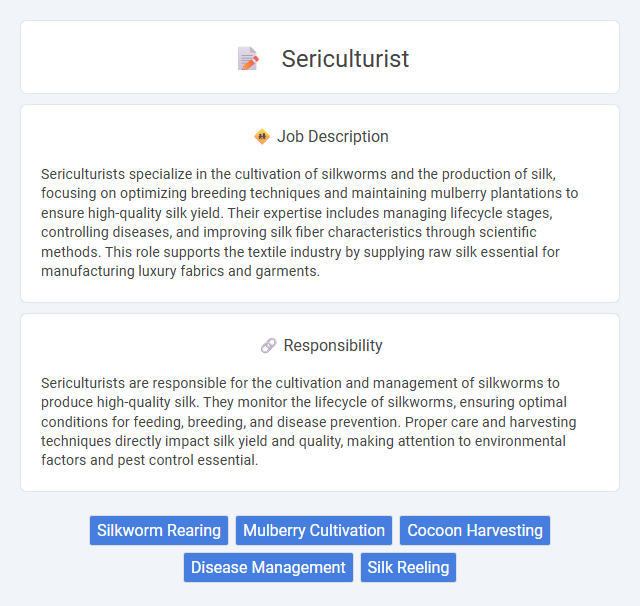
Sericulturists specialize in the cultivation of silkworms and the production of silk, focusing on optimizing breeding techniques and maintaining mulberry plantations to ensure high-quality silk yield. Their expertise includes managing lifecycle stages, controlling diseases, and improving silk fiber characteristics through scientific methods. This role supports the textile industry by supplying raw silk essential for manufacturing luxury fabrics and garments.
Individuals who are patient, detail-oriented, and enjoy working with nature are more likely to thrive as sericulturists, given the meticulous care required for silkworm cultivation. Those with physical stamina and the ability to work in controlled environments may find the job suitable, as it often involves repetitive tasks and maintaining specific temperature and humidity levels. People who prefer dynamic, rapidly changing work environments might find sericulture less appealing due to its steady, routine nature focused on long-term cultivation cycles.
Qualification
Sericulturists typically require a bachelor's degree in agriculture, horticulture, or a related field, emphasizing entomology and crop science for effective silkworm rearing and mulberry cultivation. Specialized training in sericulture techniques, pest management, and silk extraction processes enhances practical knowledge and operational efficiency. Certification courses in sericulture or agricultural extension services offer additional expertise, facilitating advancements in silk production and quality control.
Responsibility
Sericulturists are responsible for the cultivation and management of silkworms to produce high-quality silk. They monitor the lifecycle of silkworms, ensuring optimal conditions for feeding, breeding, and disease prevention. Proper care and harvesting techniques directly impact silk yield and quality, making attention to environmental factors and pest control essential.
Benefit
Working as a sericulturist could offer significant benefits, such as steady income from cultivating and harvesting silkworms for silk production. The role might promote sustainable agricultural practices, contributing to environmental preservation. There is also a potential for career growth in research, silk manufacturing, and export industries.
Challenge
Sericulture may present challenges related to the delicate nature of silkworms, requiring precise temperature and humidity control to ensure optimal growth and silk production. There is a probability that infestations or diseases could impact cocoon quality, demanding vigilant monitoring and timely interventions. Managing these complexities effectively influences the overall success and sustainability of silk farming operations.
Career Advancement
Sericulturists specializing in silk production can advance their careers by gaining expertise in sericulture technology, pest management, and sustainable farming practices. Progression opportunities include roles such as farm manager, research scientist, or quality control specialist within agricultural firms or textile industries. Continuous professional development and mastery of modern sericulture techniques enhance prospects for leadership positions and consultancy roles in the silk manufacturing sector.
Key Terms
Silkworm Rearing
Sericulturists specialize in silkworm rearing, managing the entire lifecycle of Bombyx mori to maximize silk production. They ensure optimal environmental conditions, such as temperature and humidity, and provide proper mulberry leaves as primary feed for healthy larvae growth. Expertise in disease control and breeding techniques enhances cocoon yield and silk quality, contributing to efficient sericulture operations.
Mulberry Cultivation
Sericulturists specializing in mulberry cultivation manage the growth and maintenance of mulberry trees essential for silkworm feeding and high-quality silk production. They monitor soil health, irrigation, and pest control to ensure optimal leaf yield and nutritional content. Expertise in mulberry varieties and sustainable agricultural practices directly influences sericulture efficiency and silk yield.
Cocoon Harvesting
A sericulturist specializing in cocoon harvesting efficiently collects silk cocoons at optimal maturity to ensure high-quality silk production. Precise timing during harvesting maximizes filament length and strength, crucial for premium silk yield. Proper handling and sorting of cocoons minimize damage, directly impacting the economic value of the raw silk.
Disease Management
Sericulturists specializing in disease management monitor and control silkworm diseases such as grasserie, muscardine, and flacherie to ensure healthy cocoon production. They implement integrated pest management techniques, including biological agents and chemical treatments, to prevent outbreaks and minimize economic losses. Expertise in pathogen identification, environmental control, and silkworm nutrition is essential to maintaining optimal sericulture yields.
Silk Reeling
Sericulturists specializing in silk reeling manage the delicate process of extracting silk fibers from cocoons to produce high-quality silk threads. Expertise in temperature and humidity control, as well as precise motor skills, is essential to prevent fiber breakage during reeling. This role significantly impacts the textile industry's supply chain by ensuring the production of strong, uniform silk yarns for premium fabric manufacturing.
 kuljobs.com
kuljobs.com